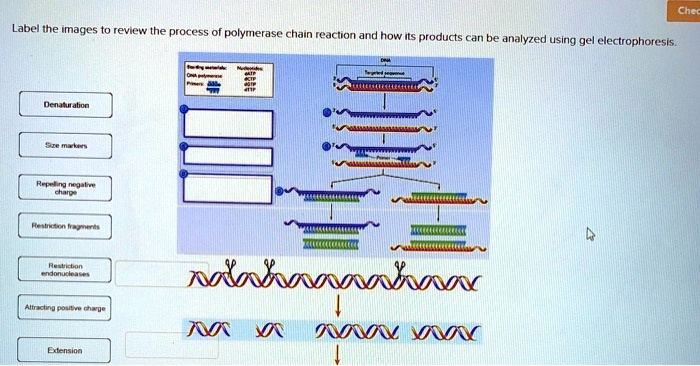Label the images review the process of polymerase chain reaction and how its products can be analyzed using gel electrophoresis. Evaluation That Here Habichton Emdmrt MAINAVA Mtnectna pLstu ^^ J MAIIA MAA Eaenain

The Correct Answer and Explanation is:
To correctly label the image and review the process of the polymerase chain reaction (PCR) and gel electrophoresis, match each label with its proper phase or feature:
- Denaturation – the DNA double helix is heated to separate into single strands
- Extension – DNA polymerase synthesizes new complementary strands
- Restriction endonucleases – enzymes cut DNA at specific recognition sites
- Restriction fragments – resulting segments of DNA after enzymatic cleavage
- Size markers – known DNA fragment lengths used for comparison
- Repelling negative charge – DNA’s phosphate backbone carries a negative charge that causes it to move
- Attracting positive charge – DNA fragments migrate toward the positive electrode during electrophoresis
PCR is a powerful technique used to amplify specific DNA sequences. It consists of three key stages that occur in cycles. First, denaturation separates the double-stranded DNA into single strands by heating. Second, annealing allows primers to bind to their complementary sequences on the target DNA. Third, extension involves DNA polymerase synthesizing new strands by adding nucleotides.
After multiple cycles, millions of copies of the target DNA region accumulate. These amplified DNA fragments are then analyzed using gel electrophoresis, a method that separates DNA based on size. The negatively charged DNA fragments are loaded into wells of an agarose gel. When an electric current is applied, the fragments migrate toward the positive electrode. Smaller fragments move faster and travel farther than larger ones, forming distinct bands.
To interpret the results, size markers are run alongside the samples. These markers consist of DNA fragments of known lengths, allowing researchers to estimate the size of unknown DNA fragments by comparing their migration distances. If restriction enzymes have been applied, they generate fragments of varying sizes depending on the presence or absence of specific sequences.
This combination of PCR and gel electrophoresis is widely used in diagnostics, forensics, and genetic research because it enables the detection and analysis of even minute amounts of DNA.
